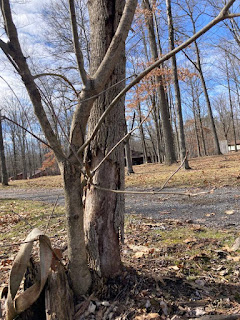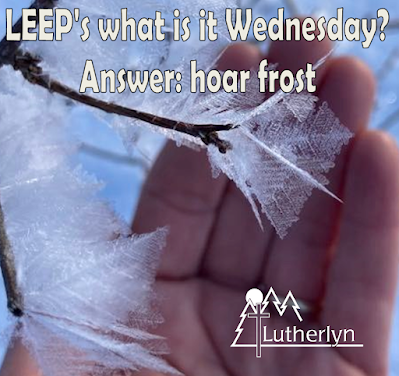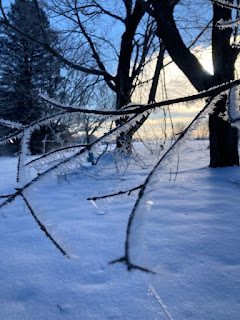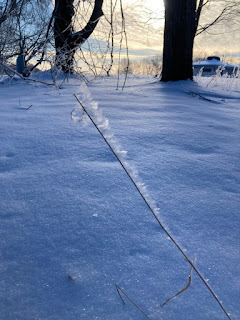Because we have solar panels at
Terra Dei Homestead at Lutherlyn, people sometimes
ask us for tips about getting started on putting up their own solar panels. We
recently had a chance to talk about this with our solar installer, John Younkin
of Blue Roof Farms. Here is what we learned from him:
Currently, the
average payback period is about 12-14 years. You will make back in electric
bill savings what you paid for the solar installation in about 12-14 years.
(That estimate does include some payback from tax credits, which non-profit
organizations do not qualify for; so for non-profits like churches or schools
the payback time would be a little longer.)
Most solar systems
today are grid-tied – this means you are still connected to the power
company as well as to your solar panels. Sometimes the solar panels provide all
the electricity you need, or even more, and sometimes you need to draw
electricity from the power company. This eliminates the need for batteries to
provide electricity when the solar panels are not producing. It also means that
during the times when a solar system is
producing more electricity than needed, it can sell the extra back to the
electric company. Off-grid systems are available too but grid-tied systems are
less expensive and very convenient.
Solar panels DO
produce electricity even on cloudy days (although a sunny day will produce
a lot more, obviously).
Do a rough estimate
of the number of solar panels you want and the cost. Solar panels and
installation currently cost about $1,300-$1,500 per panel. This is overall cost
which factors in the costs of additional equipment like inverters and wiring as
well as installation, and of course the panels. Most residential customers need
somewhere around 24-36 panels to supply all their electricity. (See below for more on how to estimate how many panels would supply all your electricity.) BUT, how many
panels you want to install is up to you – you don’t have to install enough
panels to provide ALL your electricity. Because the system is grid-tied, you
could provide half your electricity from solar panels, and half from the
electric company, or whatever you’re ready for. You also don’t have to install
all the panels you want all at one time – you can install some first and add
more later.
To estimate how many
solar panels would supply all your electricity:
- Find out how many kWh (kilowatt hours) you use
per year. This is usually printed on the lower left corner of your electric
bill.
- Divide kWh per year by 365 to find kWh per day.
- Divide kWh per day by 4.2 – this is about how
many hours a day provide power, on average, in western PA. This tells you how
many kilowatts your solar panels need to produce. (If you are in a different
geographic area, this number may be different for you.)
- Multiply kilowatts by 1,000 to find watts. Now
you know how many watts your solar panels need to produce.
- Divide the number of watts by the amount of
watts each panel produces to find out how many panels you’d need to supply all
your electricity. (There is a wide range of how many watts solar panels
produce. Our installer is currently using panels that produce 415 watts each,
so you could divide by 415 for this estimate.)
- Multiply your final result by 1.2 to account for
panels not producing exactly the number of watts they’re rated for.
To summarize:
kWh per year divided by 365 = kWh per day
kWh per day divided by 4.2 = how many kilowatts your panels need to produce in
western PA
kw times 1,000 = how many watts your panels need to produce
watts divided by 415 = how many panels would supply all your electricity
number of panels times 1.2 to make sure you have enough
(These calculations assume that your system will be grid-tied.)
Example:
The average US household uses 11,000 kWh per year, so let’s use that for our
example, although actual usage varies widely, and the usage of a church, business, school, etc., will be very
different than household usage.
11,000 / 365 = 30.1 kWh per day
30.1 / 4.2 = 7.2 kw (panels need to produce this many kilowatts)
7.2 x 1,000 = 7,200 watts (panels need to produce this many watts)
7,200 / 415 = 17.3 panels needed
17.3 x 1.2 = 20.76, round down to 20.
Someone using about 11,000 kWh per year will need 20 panels to provide all
their electricity in a grid-tied system.
20 panels x $1,500 = $30,000
Check with your power
company - find out what they need for an interconnection agreement. This is
an application to the electric company to install a solar system.
Check with your local
municipality – ask what you would need to install solar panels. (Ask about
ground installation and roof installation, in case you aren’t sure which you
will do.) They will tell you what kind of permits or inspections you will need.
Each municipality’s requirements are different.
Contact a solar
installer. A good solar installer will walk you through all of the above –
calculating how many panels you need and what type of system, giving detailed
estimates of costs, taking care of the interconnection agreement and local
permitting, as well as figuring out how to situate panels on your property and
installing the panels and system.
Advertisements you
see offering “free” solar panels to homeowners are for solar leasing companies.
If the company puts up solar panels on your property, you don’t pay for the
solar panels, but you then pay the leasing company for your electricity. It’s a legitimate
business model, not a scam, but it’s not necessarily a good deal for homeowners. The benefits are that homeowners don't have any of the up-front costs of installing solar (which is the biggest
barrier for many people), and it increases the overall use of solar power. But with a lease like this homeowners also don’t realize any of the long-term
savings of having solar panels, which could be significant over decades of not paying anything for electricity with solar panels owned outright. It’s not really free, because you pay the
leasing company for your electricity; but it is accurate that you don’t pay for
the solar panels.
Financially, solar
panels are fully viable (they pay for themselves in electric bill savings well
before the end of their useful life span of 25-50 years), and have been since
at least 2003, even here in cloudy western Pennsylvania! In addition, of course,
they provide electricity from a renewable resource and cause far less pollution
than typical electricity-generating power plants. Getting your electricity from
solar panels is a great way to care for the earth!
John can be reached at solar@bluerooffarms.com and www.BlueRoofFarms.com.



































